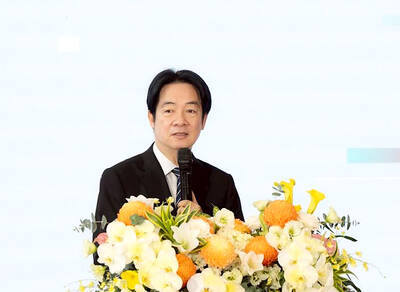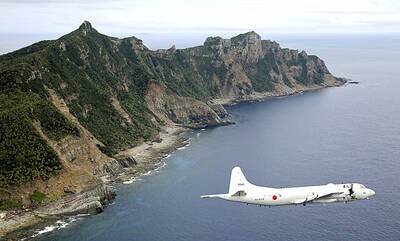The government yesterday thanked the US for approving the possible sale of a US$620 million missile repair and recertification package to Taiwan.
The US Department of State has approved the sale of a package to recertify Patriot Advanced Capability-3 (PAC-3) missiles to the Taipei Economic and Cultural Representative Office (TECRO) in Washington for an estimated US$620 million, the US Defense Security Cooperation Agency said in a news release on Thursday.
The agency has delivered the required certification to the US Congress, notifying it of the possible sale, it added.

Photo: Peter Lo, Taipei Times
The TECRO had requested to buy an upgrade package that would support an operational life of 30 years for its PAC-3 missiles, including air transportation services for missile processing, ground support equipment, and US government and contractor technical and logistical support, it said.
The proposed sale is in line with US law and policy, and serves its “national, economic and security interests by supporting the recipient’s continuing efforts to modernize its armed forces and to maintain a credible defensive capability,” it said.
“The proposed sale of this equipment and support will not alter the basic military balance in the region,” the agency said.
Lockheed Martin would be the primary contractor, it added.
The proposed sale, which is expected to take effect in one month, would be the seventh arms sale to Taiwan by US President Donald Trump’s administration, the Ministry of National Defense said in a statement yesterday.
The US, in line with its Taiwan Relations Act and “six assurances,” continues to provide Taiwan with defensive weapons, and the missile refurbishment package would boost Taiwan’s self-defense capabilities, it said, thanking the US for the decision.
As President Tsai Ing-wen (蔡英文) mentioned in her second inaugural speech, Taiwan has over the past four years worked to reform its national defense sector, as well as participate on the global stage, the Ministry of Foreign Affairs said.
These efforts — which are to continue over the next four years — seek to maintain cross-strait peace and stability, and to allow Taiwan to become more involved in fostering peace, stability and prosperity in the Indo-Pacific region, it said, adding that bilateral security partnerships would only deepen.
“Taiwan will continue to increase investment, and research and development in the defense sector in a bid to add to long-term peace, stability and prosperity in the Indo-Pacific region,” Presidential Office spokesman Alex Huang (黃重諺) said.
The nation’s oldest PAC-3 ground systems and missiles, which were purchased from the US nearly 10 years ago, need maintenance, Taiwan Security Analysis Center director Mei Fu-hsing (梅復興) wrote on Facebook yesterday.
The refurbishment would cover 444 PAC-3 systems and missiles bought over the years, Mei said.
Just like the previous arms package sale announced on May 20, the new proposal shows a normalization of arms sales between the US and Taiwan, he added.
Taiwan, like any other country, can tender arms purchase proposals to the US at any time, and the US reviews them upon request, as per legal procedure, instead of holding the proposals and then “clearing the warehouse” all at once, he said.
That was one of the Taiwan-friendly policies instituted by Randall Schriver during his tenure as US assistant secretary of defense for Indo-Pacific security affairs, Mei added.
Additional reporting by CNA

MISINFORMATION: The generated content tends to adopt China’s official stance, such as ‘Taiwan is currently governed by the Chinese central government,’ the NSB said Five China-developed artificial intelligence (AI) language models exhibit cybersecurity risks and content biases, an inspection conducted by the National Security Bureau (NSB) showed. The five AI tools are: DeepSeek, Doubao (豆包), Yiyan (文心一言), Tongyi (通義千問) and Yuanbao (騰訊元寶), the bureau said, advising people to remain vigilant to protect personal data privacy and corporate business secrets. The NSB said it, in accordance with the National Intelligence Services Act (國家情報工作法), has reviewed international cybersecurity reports and intelligence, and coordinated with the Ministry of Justice Investigation Bureau and the National Police Agency’s Criminal Investigation Bureau to conduct an inspection of China-made AI language

LIMITS: While China increases military pressure on Taiwan and expands its use of cognitive warfare, it is unwilling to target tech supply chains, the report said US and Taiwan military officials have warned that the Chinese People’s Liberation Army (PLA) could implement a blockade within “a matter of hours” and need only “minimal conversion time” prior to an attack on Taiwan, a report released on Tuesday by the US Senate’s China Economic and Security Review Commission said. “While there is no indication that China is planning an imminent attack, the United States and its allies and partners can no longer assume that a Taiwan contingency is a distant possibility for which they would have ample time to prepare,” it said. The commission made the comments in its annual

‘TROUBLEMAKER’: Most countries believe that it is China — rather than Taiwan — that is undermining regional peace and stability with its coercive tactics, the president said China should restrain itself and refrain from being a troublemaker that sabotages peace and stability in the Indo-Pacific region, President William Lai (賴清德) said yesterday. Lai made the remarks after China Coast Guard vessels sailed into disputed waters off the Senkaku Islands — known as the Diaoyutai Islands (釣魚台) in Taiwan — following a remark Japanese Prime Minister Sanae Takaichi made regarding Taiwan. Takaichi during a parliamentary session on Nov. 7 said that a “Taiwan contingency” involving a Chinese naval blockade could qualify as a “survival-threatening situation” for Japan, and trigger Tokyo’s deployment of its military for defense. Asked about the escalating tensions

DISPUTE: A Chinese official prompted a formal protest from Tokyo by saying that ‘the dirty head that sticks itself out must be cut off,’ after Takaichi’s Taiwan remarks Four armed China Coast Guard vessels yesterday morning sailed through disputed waters controlled by Japan, amid a diplomatic spat following Japanese Prime Minister Sanae Takaichi’s comments on Taiwan. The four ships sailed around the Senkaku Islands — known as the Diaoyutai Islands (釣魚台) to Taiwan, and which Taiwan and China also claim — on Saturday before entering Japanese waters yesterday and left, the Japan Coast Guard said. The China Coast Guard said in a statement that it carried out a “rights enforcement patrol” through the waters and that it was a lawful operation. As of the end of last month,